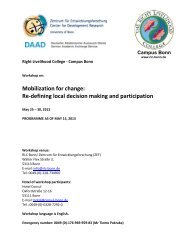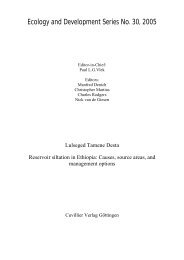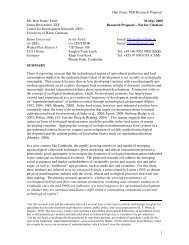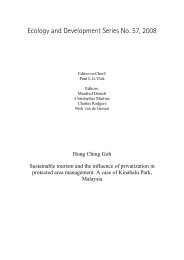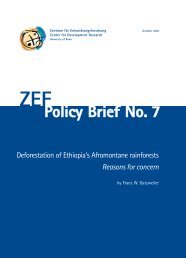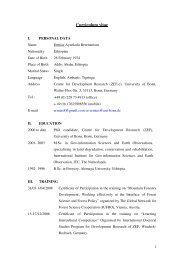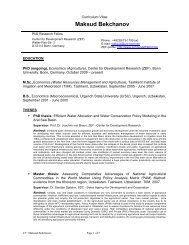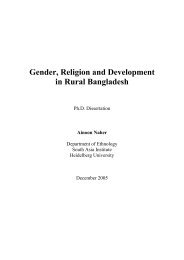Ecology and Development Series No. 10, 2003 - ZEF
Ecology and Development Series No. 10, 2003 - ZEF
Ecology and Development Series No. 10, 2003 - ZEF
- No tags were found...
You also want an ePaper? Increase the reach of your titles
YUMPU automatically turns print PDFs into web optimized ePapers that Google loves.
Description of the study area <strong>and</strong> sampling design<strong>and</strong> all plants that had fruits <strong>and</strong> flowers during the survey were collected, identified <strong>and</strong>deposited at the National Herbarium of Ethiopia (ETH), Addis Ababa University. The listof voucher specimens can be found in Appendix 8. The nomenclature of plant names inthis study follows the Flora of Ethiopia (Edwards et al. 1997, 2000; Hedberg <strong>and</strong> Edwards1989, 1995) <strong>and</strong> Cufodontis (1953-1972).Altitude, slope <strong>and</strong> aspect were recorded in the major plots. Geographicalpositions were also recorded in degrees <strong>and</strong> UTM at all major plots. Soil samples werecollected from the top 20 cm in each of the 9 m 2 subplots <strong>and</strong> mixed to obtain arepresentative sample for each plot. The samples were air-dried <strong>and</strong> passed through a 2 mmsieve prior to chemical <strong>and</strong> physical analysis, which were performed at the Water WorksDesign <strong>and</strong> Construction Enterprise (WWDCE) Soils lab, Ethiopia <strong>and</strong> the Institute forPlant Nutrition (IPN), the University of Bonn, following st<strong>and</strong>ard procedures (Allen 1989).At WWDCE, all soil samples were assayed for particle size distribution, percent moisture,CEC, available P, available K <strong>and</strong> pH <strong>and</strong> at IPN for C <strong>and</strong> N ratio. For the C-N ratioanalysis, an automated C-N analyzer (EURO EA Elemental Analyzer) was used.Abundance <strong>and</strong> frequency of all tree, shrub <strong>and</strong> climber species encountered in thestudy plots were compiled on a plot basis. Abundance is the number of stems per plot. Twosets of the abundance values were calculated, i.e., average abundance per plot wascalculated by dividing the sum of the number of stems of a species from all plots throughthe total number of plots (maximum frequency). Local abundance was calculated as theratio of the total number of stems of a species divided by its absolute frequency (as inGrace et al. 2000). Absolute frequency of a species is the number of plots in which thespecies was recorded. Relative frequency of a species is the ratio of absolute frequency ofthe species to the total number of study plots (which is equal to maximum frequency).The basal area (BA) was calculated for all species from diameter (D) at breastheight, using the formula BA = π (D/2) 2 . Average canopy cover was taken for each plot asa simple mean for the canopy cover estimate in each 9 m 2 subplot using a densiometer.Aspect, or the direction that a slope faces, was measured in degrees <strong>and</strong> transformedgeometrically to eastness (sin(aspect)) <strong>and</strong> northness (cos(aspect)) sensu Roberts (1986)<strong>and</strong> Palmer (1993).34



